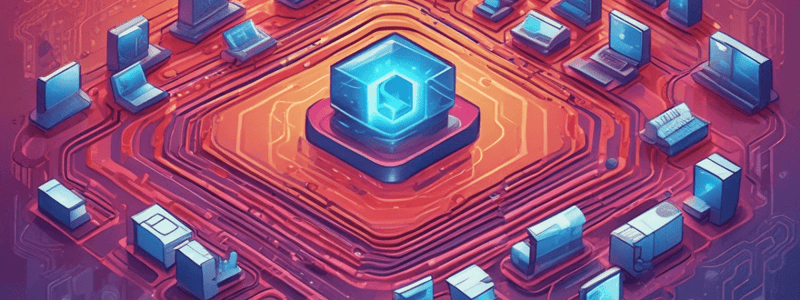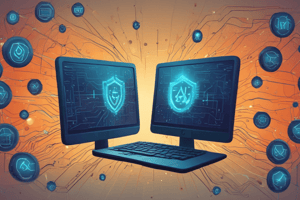Podcast
Questions and Answers
What is the primary aim of the Anti-virus and Malicious Code Policy?
What is the primary aim of the Anti-virus and Malicious Code Policy?
- Protecting networks and devices from various forms of malicious software (correct)
- Enforcing strict controls on obtaining files and software from external networks
- Requiring regular scanning for viruses and malware
- Defining roles and responsibilities for different personnel
Who is responsible for providing timely updates and support for the anti-virus solution?
Who is responsible for providing timely updates and support for the anti-virus solution?
- Third-party vendors (correct)
- IT security manager
- Users
- Server administrators
What is required for all systems connected to the network running any version of Microsoft Windows?
What is required for all systems connected to the network running any version of Microsoft Windows?
- Regular scanning for viruses
- Installation of an anti-virus solution (correct)
- Strict controls on obtaining files and software from external networks
- A risk assessment for other operating systems
What are users required to do regarding unsolicited or suspicious emails?
What are users required to do regarding unsolicited or suspicious emails?
What is the consequence of policy violations according to the policy?
What is the consequence of policy violations according to the policy?
What is mandated for obtaining files and software from external networks?
What is mandated for obtaining files and software from external networks?
Who are the defined roles and responsibilities for, according to the policy?
Who are the defined roles and responsibilities for, according to the policy?
What is required for systems running any version of Microsoft Windows, and what is required for other operating systems?
What is required for systems running any version of Microsoft Windows, and what is required for other operating systems?
What are the specific guidelines provided for regarding anti-virus scanning and configuration?
What are the specific guidelines provided for regarding anti-virus scanning and configuration?
Study Notes
Anti-virus and Malicious Code Policy Overview
- The policy aims to protect networks and devices from malicious software, including viruses, worms, Trojans, spyware, and malware.
- It is designed to minimize the impact on business in case of a malicious software breach and to meet PCI DSS requirements.
- The policy applies to all information processing facilities and mobile computing devices under the company's control, including workstations, servers, and other technology.
- Roles and responsibilities are defined for client, server, and anti-virus administrators, IT security manager, users, and third-party vendors.
- The policy mandates the use of approved anti-virus software, regular scanning for viruses, and strict controls on obtaining files and software from external networks.
- Users are required to be vigilant against unsolicited or suspicious emails, scan media from unknown sources for viruses, and report any suspected or detected viruses immediately.
- The policy requires third-party vendors to provide timely updates and support for the anti-virus solution on a 24x7 basis.
- Specific guidelines are provided for anti-virus scanning and configuration, including proactive and periodic scanning for viruses and scanning of files received on removable media.
- All systems connected to the network running any version of Microsoft Windows must have an anti-virus solution installed, and a risk assessment is required for other operating systems.
- Different anti-virus solutions are recommended for gateway virus scanning and email content scanning, with specific requirements for scanning web traffic and email attachments.
- Enforcement measures include the possibility of disciplinary action for policy violations, with deviations permitted only with a valid business case reviewed and approved by the Security Management Team and/or Legal Counsel.
- The policy references the Payment Card Industry Data Security Standard (PCI DSS) as part of its requirements.
Studying That Suits You
Use AI to generate personalized quizzes and flashcards to suit your learning preferences.




